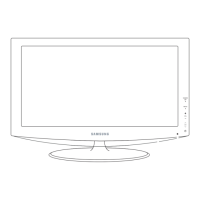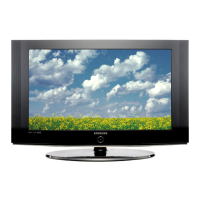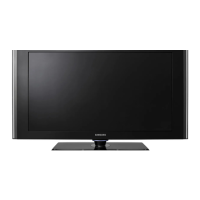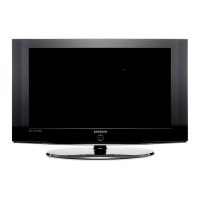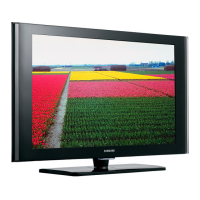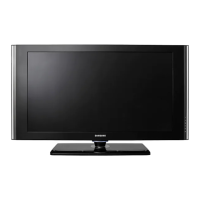Do you have a question about the Samsung TELEVISOR LTM1755B and is the answer not in the manual?
Detailed safety precautions for TV operation and maintenance.
Lists the key features and capabilities of the new TV.
Identifies all included components and accessories with the TV.
Overview of the TV and functions of its top panel buttons.
Details all connection ports available on the back of the TV.
Describes the functions and layout of the remote control for TV operation.
Guides for connecting various types of antennas to the TV.
Instructions for connecting 75-ohm round cable antennas.
How to connect two separate VHF and UHF antennas.
Steps for connecting the TV to a cable TV system, with or without a decoder.
How to connect set-top boxes for universal or partial channel decoding.
Steps to connect a VCR for playback and viewing.
How to connect an S-VHS VCR for improved video quality.
Guides for connecting a DVD player to the TV for playback.
Instructions for connecting a digital TV receiver.
How to connect a video camera to view footage directly.
Step-by-step guide to insert batteries into the remote control.
How to power the TV on and off using the remote or panel buttons.
Accessing and navigating TV menus and viewing screen information.
Guide to changing the TV's menu display language.
Managing TV channels, including auto-tuning, manual addition/deletion.
Ways to switch between TV channels using various remote functions.
Adjusting audio volume and using the mute function.
Adjusting picture settings like contrast, brightness, and color.
Activating pre-set picture modes for optimal viewing.
Adjusting sound settings like bass, treble, and virtual surround.
Activating pre-set sound modes for different audio experiences.
Selecting and viewing external video sources connected to the TV.
Manually adjusting channel reception for optimal signal quality.
Enhancing reception in weak signal areas by boosting input signal.
Adjusting the aspect ratio of the displayed image (e.g., 4:3, 16:9).
How to pause a moving image on the screen.
Advanced audio settings including stereo, mono, and SAP selection.
Enabling a virtual Dolby cinema sound effect through TV speakers.
Scheduling the TV to turn off automatically after a set period.
Enabling and configuring subtitles for TV programs.
Using and enabling the Picture-in-Picture (PIP) viewing mode.
Selecting PIP sources and controlling window position and size.
Managing parental controls using V-Chip, including PIN setup.
Enabling or disabling the V-Chip parental control system.
Configuring program blocking based on TV rating systems.
Setting program blocks based on movie rating systems (MPAA).
General information on using the TV as a PC display.
Steps to connect a PC and configure the TV for optimal display.
Software configuration steps on a Windows PC for TV display.
Fine-tuning picture settings for optimal PC image clarity.
Adjusting the horizontal and vertical position of the PC image.
Selecting the correct color system for PC display.
Fine-tuning specific color parameters (Red, Green, Blue).
Resetting screen position or color settings to default values.
A guide to common TV issues and their potential solutions.
Steps for attaching a VESA mount to the TV.
Instructions for mounting the TV on a stand or wall.
Recommended procedures for cleaning and general care of the LCD TV.
Information on the TV's adjustable tilt stand.
How to install and use a Kensington security lock.
Details pin configurations for various connectors.
Information on supported screen resolutions and refresh rates.
Using the TV with different broadcast systems abroad.
Technical details and specifications for the TV models.
Detailed safety precautions for TV operation and maintenance.
Lists the key features and capabilities of the new TV.
Identifies all included components and accessories with the TV.
Overview of the TV and functions of its top panel buttons.
Details all connection ports available on the back of the TV.
Describes the functions and layout of the remote control for TV operation.
Guides for connecting various types of antennas to the TV.
Instructions for connecting 75-ohm round cable antennas.
How to connect two separate VHF and UHF antennas.
Steps for connecting the TV to a cable TV system, with or without a decoder.
How to connect set-top boxes for universal or partial channel decoding.
Steps to connect a VCR for playback and viewing.
How to connect an S-VHS VCR for improved video quality.
Guides for connecting a DVD player to the TV for playback.
Instructions for connecting a digital TV receiver.
How to connect a video camera to view footage directly.
Step-by-step guide to insert batteries into the remote control.
How to power the TV on and off using the remote or panel buttons.
Accessing and navigating TV menus and viewing screen information.
Guide to changing the TV's menu display language.
Managing TV channels, including auto-tuning, manual addition/deletion.
Ways to switch between TV channels using various remote functions.
Adjusting audio volume and using the mute function.
Adjusting picture settings like contrast, brightness, and color.
Activating pre-set picture modes for optimal viewing.
Adjusting sound settings like bass, treble, and virtual surround.
Activating pre-set sound modes for different audio experiences.
Selecting and viewing external video sources connected to the TV.
Manually adjusting channel reception for optimal signal quality.
Enhancing reception in weak signal areas by boosting input signal.
Adjusting the aspect ratio of the displayed image (e.g., 4:3, 16:9).
How to pause a moving image on the screen.
Advanced audio settings including stereo, mono, and SAP selection.
Enabling a virtual Dolby cinema sound effect through TV speakers.
Scheduling the TV to turn off automatically after a set period.
Enabling and configuring subtitles for TV programs.
Using and enabling the Picture-in-Picture (PIP) viewing mode.
Selecting PIP sources and controlling window position and size.
Managing parental controls using V-Chip, including PIN setup.
Enabling or disabling the V-Chip parental control system.
Configuring program blocking based on TV rating systems.
Setting program blocks based on movie rating systems (MPAA).
General information on using the TV as a PC display.
Steps to connect a PC and configure the TV for optimal display.
Software configuration steps on a Windows PC for TV display.
Fine-tuning picture settings for optimal PC image clarity.
Adjusting the horizontal and vertical position of the PC image.
Selecting the correct color system for PC display.
Fine-tuning specific color parameters (Red, Green, Blue).
Resetting screen position or color settings to default values.
A guide to common TV issues and their potential solutions.
Steps for attaching a VESA mount to the TV.
Instructions for mounting the TV on a stand or wall.
Recommended procedures for cleaning and general care of the LCD TV.
Information on the TV's adjustable tilt stand.
How to install and use a Kensington security lock.
Details pin configurations for various connectors.
Information on supported screen resolutions and refresh rates.
Using the TV with different broadcast systems abroad.
Technical details and specifications for the TV models.
| Screen Size | 17 inches |
|---|---|
| Display Technology | LCD |
| Aspect Ratio | 5:4 |
| Contrast Ratio | 500:1 |
| Brightness | 250 cd/m² |
| Response Time | 25 ms |
| Input Ports | VGA, DVI |
| Viewing Angle | 160° (H) / 140° (V) |
| Resolution | 1280 x 1024 pixels |

